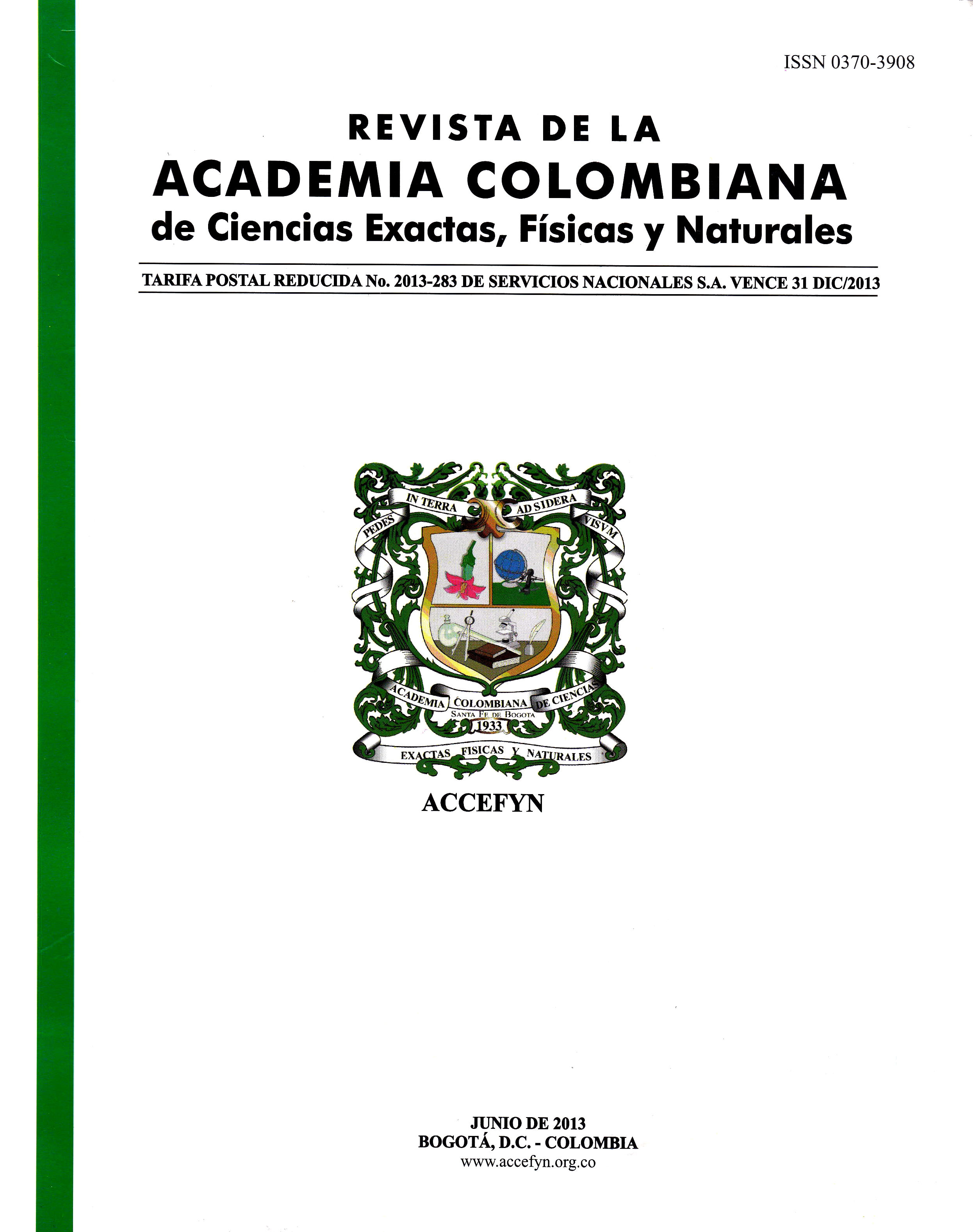Resumen
Se determinó el comportamiento de FHIA-20 y FHIA-23 a Mycosphaerella fijiensis y M. musicola. El estudio se realizó en una casa de malla en la granja Montelindo de la Universidad de Caldas, a 1010 msnm, temperatura media de 22.8 °C, precipitación anual de 2200 mm, humedad relativa del 76%. Se inoculó conidias de Paracercospora fijiensis y Pseudocercospora musae, y la combinación de ambos, en plántulas entre cuatro y seis hojas. Se evaluó período de incubación (PI), tiempos de evolución de síntomas (TES) y desarrollo de las enfermedades (TDE), además, número de lesiones por hoja (NLH). En FHIA-20, P. musae, P. fijiensis y P. musae + P. fijiensis tuvieron un PI más largo que en Dominico Hartón, superior en 3, 20 y 10 días, respectivamente; así mismo, el TES de las sigatokas amarilla y negra y la combinación de ambas, fue más prolongado en FHIA-20, en 5, 49 y 26 días que en el material local, respectivamente. En FHIA-23, P. musae, P. fijiensis y P. musae + P. fijiensis presentaron 2, 6 y 3 días más de PI, respectivamente, que en Gros Michel; además, FHIA-23 presentó un TDE de las sigatokas amarilla y negra y la combinación de ambas, superiores a Gros Michel en 9, 16 y 11 días, respectivamente; comportándose FHIA-20 altamente resistente y tolerante a las sigatokas negra y amarilla, respectivamente, y FHIA-23 resistente.
Referencias
Aguirre-Gaviria, M. C. (Q.E.P.D.) & J. Castaño-Zapata. 2005. Epidemiología de Mycosphaerella fijiensis Morelet y M. musicola Leach, en siete genotipos de musáceas. Fitopatología Colombiana 29(1): 7-11.
Álvarez, J. 1997. Introducción, evaluación, multiplicación y diseminación de híbridos FHIA en Cuba. InfoMusa 6(2): 10-14.
Belalcazar, C.S.L., P. M. I. Arcila, M. L. A. Valencia, H. Reichel & V. J. Narvaez. 1996. Efecto del virus del Mosaico del pepino, CMV, sobre los parámetros de crecimiento, desarrollo y producción del clon de banano Gros Michel. Tecnología del eje cafetero para la siembra y explotación rentable del cultivo del plátano. Comité de Cafeteros del Quindío, Armenia. Pp: 88-94.
Castaño-Zapata J.; D. R. MacKenzie & R. R. Nelson. 1989. Components analysis of race non-specific resistance to blast disease of rice caused by Pyricularia oryzae. Phytopathology Z. 127: 89-99.
Chuang, T. Y. 1981. Chemical control of banana leaf spot caused by Mycosphaerella fijiensis var . difformis. Plant Prot. Bull. 23:87-94.
Corpoica. 2000. Plan de investigación y transferencia para aumentarla sostenibilidad y competitividad del plátano en Colombia. http://www.corpoica.org.co/html/planes/platano/texto/Platano.html
Craenen, K. 1998. Black Sigatoka disease of banana and plantain. A reference manual. Ibadan, Nigeria: International Institute of Tropical Agriculture. Pp. 9-34.
Du Pont. 1983. Sigatoka negra y amarilla. Técnicas mejoradas para manejo e identificación. Coral Gables, Florida. 14p.
Fundación Hondureña de Investigación Agrícola, FHIA. 1996. Programa de banano y plátano. La Lima, Cortés. Honduras, C.A. Pp. 1-8.
Hoyos-Castaño, J. E & J. Castaño-Zapata. 2005. Estudio de algunos componentes de resistencia en cuatro materiales de plátano y banano a las sigatokas negra (Mycosphaerella fijiensis Morelet) y amarilla (Mycosphaerella musicola Leach). Fitopatología Colombiana 29(1): 12-14.
Jacome, L. & W. Schuh. 1993. Spore production and artificial inoculation techniques for Mycosphaerella fijiensis var. difformis. Trop. Agric. 70(1):33-38.
Merchan, V. V. M. 1996. Prevención y manejo de la Sigatoka negra. Manizales. ICA. Pp 1-14.
Merchan, V. V. M. 1998. Manejo de problemas fitosanitarios del cultivo del plátano en la zona cafetera central. Memorias Seminario Internacional Sobre Producción de Plátano, Armenia, Quindío. Pp. 177-191.
Mobambo, K. N., M. Naku & Z. Nganga. 1993. La enfermadad de la Sigatoka negra del banano y plátano en Zaire. InfoMusa 2(2): 14-15.
Mobambo, K. N., C. Pasberg-Gauhl, F. Gauhl & K. Zuofa. 1994. Selección precoz de la resistencia a la enfermedad de la Sigatoka negra bajo condiciones de inoculación natural. InfoMusa 3(2): 14-16.
Molina-Tirado, O. I. & J. Castaño-Zapata. 2003. Análisis de algunos componentes de resistencia en los híbridos de banano y plátano FHIA-01, FHIA-17 y FHIA-21 a las Sigatokas negra (Mycosphaerella fijiensis Morelet) y amarilla (M. musicola Leach). Revista de la Academia Colombiana de Ciencias Exactas, Físicas y Naturales 27(103): 181-190.
Mourichon, X., D. Peter & M. F. Zapater. 1987. Inoculation expérimentale de Mycosphaerella fijiensis Morelet sur de jeunes plantules de bananiers issues de culture in vitro. Fruits 42(4):195-198.
Mourichon, X. & R. A. Fullerton. 1990. Geographical distribution of the two species Mycosphaerella musicola Leach (Cercospora musae) and Mycosphaerella fijiensis Morelet (Cercospora fijiensis), respectively agents of Sigatoka diseases in bananas and plantains. Fruits 45(3): 213-218.
Noupadja, P. & K. Tomekpe. 1999. Desempeño agronómico de seis cultivares de Musa mejorados del IITA en condiciones agroecológicas de Mbalmayo (Camarún). InfoMusa 8(2): 13-15.
Orjeda, G. 1998. Evaluación de la resistencia de los bananos a las enfermedades de Sigatoka y Marchitamiento por Fusarium. Roma, Italia. Instituto Interamericano de Recursos Fitogenéticos. (Guías Técnicas INIBAP 3). Pp. 1-61.
Orjeda, G., J. Escalant & N. Moor. 1998. Programa internacional de evaluación de Musa (IMTP) fase II sinopsis del informe final y resumen de los resultados. InfoMusa 8(1): 3-10.
Pasberg-Gauhl, C. 1990. Development of black Sigatoka disease (Mycosphaerella fijiensis) on different banana and plantain clones propagated gy rhizomes and shoot-tip-culture in Costa Rica. Report of the first research coordination meeting on mutation breeding of bananas and plantain, FAO/IAEA, Vienna, Austria. Pp. 41-55.
Pérez, V. 1998. Control de la Sigatoka negra en Cuba: Un enfoque de manejo integrado de la enfermedad. InfoMusa 7(1): 26-30.
Ploetz, R. 1999. The most important disease of a most important fruit. [en línea]: APSnet feature, March 1 thru april 6, 1999. [ Consulta: 3 de marzo de 2000].
Romero, A. R. & T. B. Sutton. 1997. Sensitivity of Mycosphaerella fijiensis, causal agent of black Sigatoka of banana, to propiconazole. Phytopathology 87: 96-100.

Esta obra está bajo una licencia internacional Creative Commons Atribución-NoComercial-SinDerivadas 4.0.
Derechos de autor 2023 Revista de la Academia Colombiana de Ciencias Exactas, Físicas y Naturales

